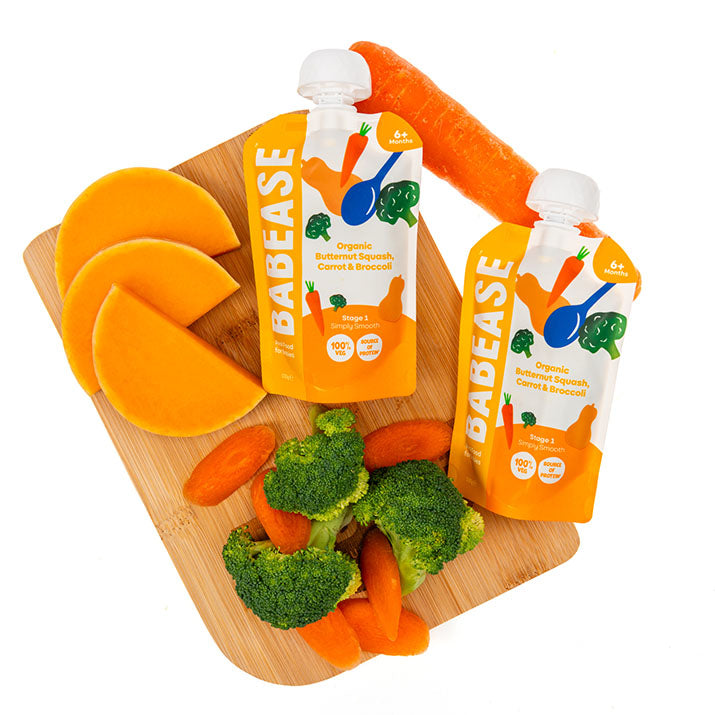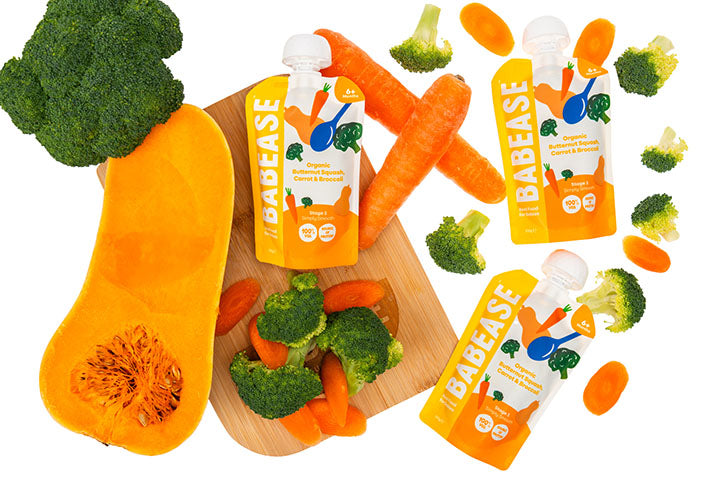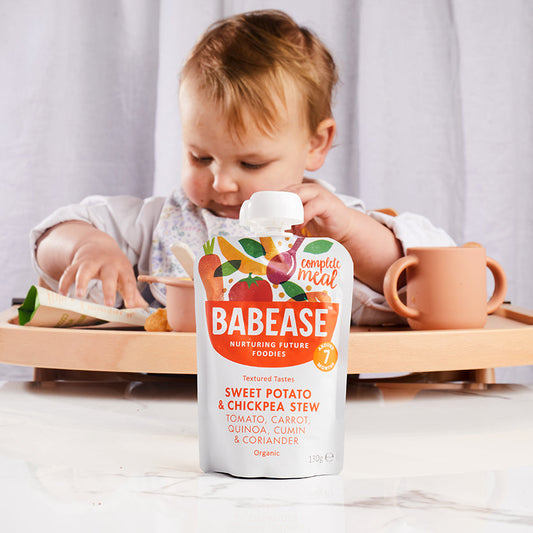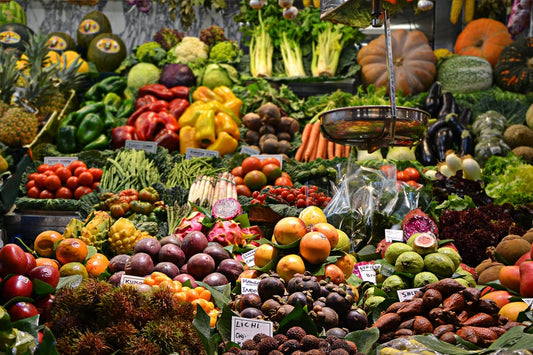DAIRY FREE WEANING: ADVICE FROM OUR NUTRITIONIST
Weaning with an allergy can feel overwhelming and, at times, pretty scary too. If you are navigating the weaning journey whilst also managing your little one’s cow’s milk allergy, we are here to help. In this blog, our company nutritionist, Catherine Lippe, explains what you need to know about weaning with a cow’s milk allergy.
First things first, if your baby has already been diagnosed with an allergy to cow’s milk, or if you suspect they might be allergic, it is important to seek advice from your GP, a paediatric dietitian or allergy specialist. These health professionals are the experts and will be able to offer careful and bespoke advice to help you manage your little one’s allergies.
First Foods for Milk Free Weaning
Having a cow’s milk allergy doesn’t have to affect your baby’s first flavours and the advice to start weaning with vegetables remains the same. Examples of vegetables to try include broccoli, avocado, cauliflower, green beans, peas, courgette, asparagus, spinach, kale, potato. You can read more about the importance of a vegetable led approach to weaning here.
Start with one meal a day from around six months or when your baby is developmentally ready. You should keep up with all your baby’s usual milk feeds too. If you are not breastfeeding, your GP or paediatric dietitian might have already prescribed you a specialist formula milk such as an extensively hydrolysed or amino acid-based formula.
When it comes to solid food, you can offer a new vegetable every day, and it’s a good idea to keep a record of the foods you offer. This helps to track the foods your baby has tried and tolerated so far. If your baby has a reaction to any of the foods, you can record these symptoms alongside the food and discuss this with your GP or allergy specialist.
Progressing With Weaning
As your baby adapts to solid food and begins to accept more of the foods you offer, you can include more variety in your baby’s diet and gradually increase the number of meals a day to two and then three meals a day. Every baby is different, and some babies will take longer to accept solid food and move to three meals a day.
Follow your baby’s lead, and don’t worry if they get off to a slow start. Focus on having fun with food and allow them to touch, play with and explore their food until they feel more confident. Keep up with their usual milk feeds (breast or a suitable formula) in between meals to ensure they are getting lots of energy and nutrition.
Protein and iron-rich foods such as meat, fish, eggs, beans, and pulses are useful to introduce at this stage of dairy free weaning to boost your baby’s iron intake. You can also include carbohydrate foods such as pasta, rice, potato, oats, and bread. You will need to take care to avoid all dairy products and any foods that contain cow’s milk, but otherwise, you can continue with weaning as normal.
Avoiding Cow’s Milk
If your baby has an allergy to cow’s milk, you will need to avoid all types of dairy food in their weaning diet. Examples of these foods include cheese, yoghurt, fromage frais, milk, butter, cream, ice cream, custard etc.
It is also necessary to carefully check the food labels on the products you buy. If the food contains cow’s milk, it will be listed in the ingredients on the back of the pack; however, it might not always be obvious. Look out for, and avoid, any of the following, which all refer to ingredients derived from cow’s milk.
- Cow’s milk (fresh, UHT)
- Casein (curds), caseinates
- Evaporated milk
- Calcium or sodium caseinate
- Condensed milk
- Hydrolysed casein
- Buttermilk
- Whey, whey solids, whey powder, whey protein, whey syrup sweetener, hydrolysed whey protein
- Butter, butter oil
- Ghee
- Cheese
- Milk powder, skimmed milk powder, milk sugar, milk protein, non-fat milk solids, modified milk
- Yoghurt
- Fromage Frais
- Margarine
- Ice cream
- Cream/artificial cream
- Lactoglobulin
- Lactalbumin
Introducing Other Allergens to Your Baby’s Diet
If your baby has an allergy to cow’s milk, they may be at increased risk of developing other allergies. There are 14 main food allergens (listed below), and it is recommended that you introduce these foods one at a time, leaving a gap of approximately three days between each allergen.
The 14 main allergens include:
- Egg
- Peanut
- Tree nuts, such as almonds, brazil nuts, cashews, hazelnuts, macadamia, pecan, pistachios, walnuts
- Sesame
- Soya (babies with an allergy to cow’s milk may also react to soya because the proteins are very similar)
- Fish
- Wheat
- Crustaceans, such as crab, lobster, crayfish, shrimps, prawns
- Molluscs, such as mussels, clams, octopus, squid
- Cow’s milk (don’t offer this allergen if your baby has a cow’s milk allergy)
- Mustard
- Celery
- Lupin
- Sulphur Dioxide/Sulphites
After the first couple of weeks of weaning, and once your baby has experienced their first flavours, you can begin offering a wider variety of foods, including these allergens. It’s normal to feel nervous about trying these allergens for the first time.
If you are feeling anxious, talk it through with your GP or allergy specialist, but try not to put off introducing them. Evidence shows that delaying the introduction of these allergens after 6-12 months can increase the risk of allergy.
Follow these five tips for introducing allergens to your baby:
1. Introduce allergens when your baby is feeling well and is symptom-free. If they have a rash or are recovering from a tummy upset, the indicators of a food allergy might be masked by their current symptoms.
2. Offer the foods one at a time. If your baby develops symptoms after eating several new foods, you won’t know which food it was that caused the reaction.
3. Offer the food in small doses to begin with - for example, ¼ teaspoon of cooked scrambled egg or smooth nut butter. If your baby does react, the symptoms are usually less severe if the dosage is small. You can increase the dosage of the food each time you offer it, providing your baby has not reacted.
4. Offer the food in the morning. This will allow you to observe your baby and look out for any symptoms of an allergy as the day progresses.
5. Keep a record of the foods you try and how your baby responds. If your baby tolerates the food with no reaction, continue to include the allergen in their diet regularly in order to help build up a tolerance. If your baby does react, avoid giving that food again, and speak to your GP, dietitian, or allergy specialist.
Ensuring Your Baby Isn’t Missing Out on Important Nutrients
Dairy foods are a good source of calcium, protein, iodine, vitamin B12 and B2. Your baby will be able to get these nutrients from their milk feeds (breast milk or a prescribed formula milk) during weaning, but there are some non-dairy sources of these nutrients that you can include in the dairy free baby weaning diet too.
| Calcium | Protein | Iodine | Vitamin B12 | Vitamin B2 |
|
Canned fish such as salmon or sardines with small, very well mashed bones |
Meat, Fish, Eggs, Beans, pulses and lentils |
Fish, especially white fish and shellfish Some plant-based drinks may be fortified |
Meat, Fish Eggs Fortified breakfast cereals Some plant-based drinks may be fortified |
Eggs, Fortified breakfast cereals, Mushrooms |
Dairy Free Milk for Babies
Babies with a cow’s milk allergy should continue drinking breastmilk or a prescribed infant formula milk until at least 18 months – two years of age alongside their solid food diet.
There are many plant-based milks available, and these can be used as an ingredient in cooking (e.g.] pancakes, sauces etc) or on breakfast cereal from six months but should not be offered as a drink until at least 18 months. The reason for this is because plant-based milks are not as nutritionally complete as breastmilk or formula milk and don’t contain the same amount of energy, fat, or protein.
When choosing a plant-based milk, always check the label to ensure that it is fortified with calcium and other vitamins. Soya milk can be a good alternative to cow’s milk; however, babies with an allergy to cow’s milk may also react to soya, because the proteins in soya are very similar to cow’s milk proteins, and the body may respond the same way to both.
Oat milk or coconut milk are other suitable alternatives for dairy free baby food; but be sure to check they are well fortified. Rice milk is not suitable for children under the age of 5 years, because it contains levels or arsenic that can be harmful to young children.
Where to go For Further Support with Allergens
As well as speaking to your GP or a specialist dietitian, there are some great resources on weaning with allergies from Allergy UK. You can find more information about the weaning guide here:
DesignConcept_A5_Info_Book_v1.5_original.pdf (allergyuk.org)
Butternut Squash, Carrot & Broccoli




GET 20% OFF YOUR FIRST ORDER!
Join the Baby Club for FREE weaning help and advice.







